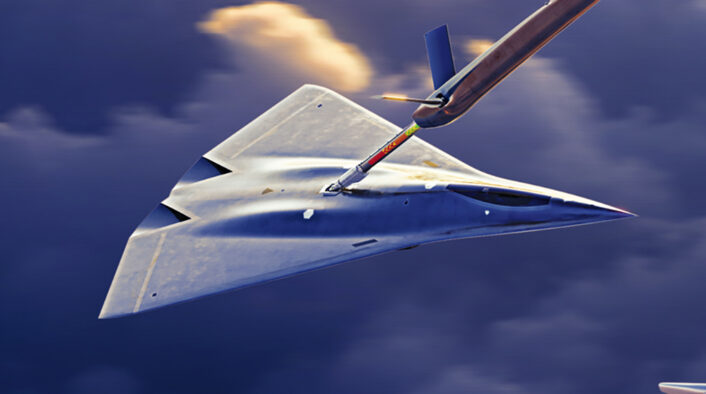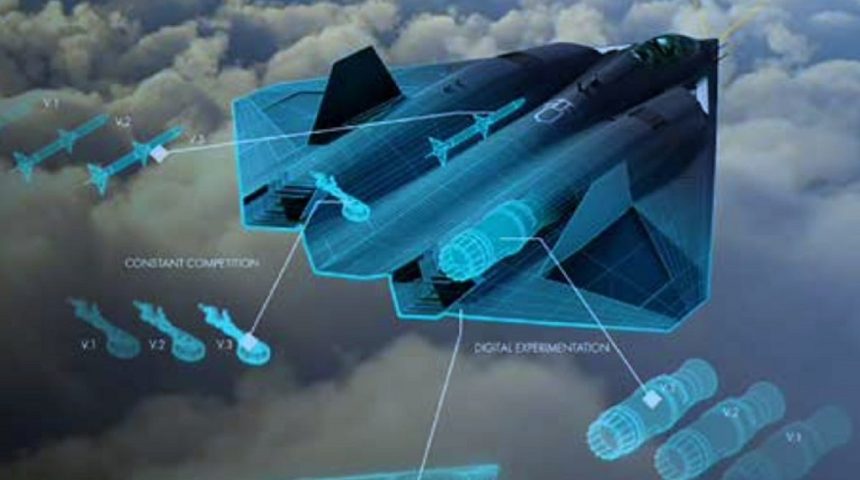The 6th generation aircraft is expected to start replacing the F-22 Raptor by the end of the decade.
As we reported earlier, the U.S. Air Force formally started the selection process for the design of the NGAD (Next Generation Air Dominance) sixth generation platform. On May 18, 2023, the Department of the Air Force released a classified solicitation to industry, providing the expected requirements of the program, with a contract award expected in 2024.
The NGAD is expected to replace the 5th gen F-22 Raptor beginning by the end of this decade, according to the Air Force’s plans. Unlike the F-22, however, NGAD is a family of systems which includes both a manned aircraft and unmanned Collaborative Combat Aircraft (CCA) also previously known as Loyal Wingmen. However, the CCA program is not part of this NGAD Platform source selection, says the press release.
“The NGAD Platform is a vital element of the Air Dominance family of systems which represents a generational leap in technology over the F-22, which it will replace,” said Secretary of the Air Force Frank Kendall. “NGAD will include attributes such as enhanced lethality and the ability to survive, persist, interoperate, and adapt in the air domain, all within highly contested operational environments. No one does this better than the U.S. Air Force, but we will lose that edge if we don’t move forward now.”
Other than this brief description, the Air Force did not release details about the requirements, mentioning that further information on the NGAD Platform’s technical and programmatic details are classified to protect operational and technological advantages. In fact, since it was first announced, NGAD has been one of the most secretive programs of the Air Force, perhaps even more than the B-21 Raider.
But what has been disclosed so far? Let’s do a recap.
The origin of the NGAD program
The NGAD program was first initiated in 2014 with DARPA’s Air Dominance Initiative study, whose goal was to develop the next air superiority fighter for the 2030s. Two years later, the Air Force started its own Air Superiority 2030 program, which in 2018 evolved in the NGAD program as we know it today.
The future 5th gen. aircraft was rumored to be a small and agile manned plane, supersonic, long-range, cyber-resilient against threats of the future interconnected world, with morphing metals, self-healing capabilities and ability to carry laser-weapons. After the start of AS2030, multiple NGAD concepts were released by the major defense industries, but they were all notional and not representative of the real designs being developed.

After the initial glamour, NGAD continued under wraps, almost unnoticed. Then, in 2020, the surprise announcement by Dr. Will Roper, then Assistant Secretary of the Air Force for Acquisition, Technology and Logistics: the U.S. Air Force had secretly designed, built and flown at least one full-scale prototype of the new generation fighter aircraft.
“We’ve already built and flown a full-scale flight demonstrator in the real world, and we broke records in doing it,” Roper said during the Air, Space and Cyber Conference 2020. “We are ready to go and build the next-generation aircraft in a way that has never happened before.”
That was pretty much it as all the details were classified, leaving many questions unanswered: number of prototypes, the manufacturer and the timing of development and first flight, the aircraft’s appearance and mission, unmanned or optionally manned capabilities, low observability and supersonic or hypersonic speeds.
The only info disclosed was that advanced Computer Aided Engineering (CAE) techniques and Digital Twin concepts were used to build and test a virtual version of the aircraft, before moving to physically build and fly the prototype. These characteristics are part of the proposed “e-Series” or “Digital Century Series” approach, which should allow the Air Force to rapidly develop and buy aircraft more frequently thanks to new improved development and manufacturing techniques.
The entire Digital Century Series should revolve around three principles: agile software development with software continuously developed, tested, released and updated based on the feedback, open architecture systems with modular hardware and software that allows rapid upgrades and integration of new, and digital engineering, or the use of advanced CAE and Digital Twin, as stated previously.
The NGAD concept arts
The hype for the announcement of the existence of a NGAD demonstrator was so high that, few days later, the Air Force created a NGAD-centered graphic for the service’s 73rd birthday, leading many to believe it was a hint at the appearance of the demonstrator. However, it was later discovered that the design appeared to be a manipulated version of a concept aircraft created few years earlier by a graphic artist.
Few months later, another concept art emerged in Air Force Acquisition Biennial Report for the NGAD’s program section. Again, the credibility of that design remained uncertain, not knowing if the Air Force have simply picked again a random, stylized, fictional aircraft that has nothing to do with the real thing.
Other notional designs were released again by the industry in the last couple of years. In 2022 Lockheed Martin released new renderings showing a manned sixth-generation fighter aircraft as a notional stand-in design for NGAD during a media briefing about the company’s proposal for the KC-Y competition. The company’s officials stressed that this isn’t necessarily what NGAD would look like.
The appearance of this 6th-gen. design is similar to the previous ones released by Lockheed Martin, showing a tailless design (considered ideal to obtain very low observability) with a diamond-shaped wing planform with straight leading and trailing edges. The aircraft features a prominent chine line (much like the F-22 and F-35), tapered almost in a straight line from the wing root to the nose.
The engines are fully contained in the fuselage, with only two bulges denoting their position on the upper fuselage. As many low-observable designs, the exhaust is located on the upper surface of the rear fuselage, shielding almost completely the infrared signature of the two-dimensional diamond-shaped nozzles. The air intakes are not visible, as they are mounted below the fuselage, flush with the joint between wing root and fuselage, as it could be seen in an older frontal rendering of the almost identical design.

Another design was teased by Northrop Grumman in 2021 and again this year in three separate 15-second videos during the last month. The aircraft in the videos appears to be a quite large tailless design, but the planform however is unknown. Two low-observable air inlets, whose shape is reminiscent of the one used by Northrop Grumman on the X-47B UCAV, are placed on the top of the fuselage, just behind the cockpit, however it can’t be said if the concept is a single or twin-engine design.
Two features that might have been inherited by the B-21 Raider, also built by Northrop Grumman and presented by the first 6th gen aircraft, are the large volume on the lower fuselage (supposedly to make space for fuel and weapons) and the nose’s “hawk beak”. These two features were less prominent in the 2021 video, showing that the model was slightly modified. Another difference is the cockpit, as in the latest videos the canopy frame is not visible, possibly showing a change from a two-piece canopy to a single-piece one.
It should be said, however, that the design appears very similar to the one shown in the older renderings released years back by Northrop Grumman, where a design with a similar nose and inlets configuration is shown in a three-quarter rear view. That older rendering showed a tailless cranked wing design, powered by a single engine and also equipped with directed energy weapons.
Although it is not known if it is related to NGAD, The War Zone spotted last year another tailless, delta-wing aircraft in satellite imagery of Area 51. The aircraft was sitting on the apron under a temporary shelter which was missing its top cover, but the resolution of the imagery did not allow to detect useful details. Only time will tell (or maybe not) if that was the NGAD demonstrator or something completely unrelated.
The confirmed details
It could be a long time before the Air Force decides to put an end to rumors and notional designs, showing for the first time the real NGAD and releasing details about its capabilities. For now, we can only count on few confirmed broad details.
NGAD will include attributes such as enhanced lethality and the ability to survive, persist, interoperate, and adapt in the air domain, all within highly contested operational environments, as mentioned in the latest press release. The Platform is one of many critical combat capabilities that will enable counter-air missions with the ability to strike both airborne and ground-based threats to achieve air superiority and support the Joint Force.
According to Secretary Kendall, the U.S. Air Force should procure 200 NGAD fighters along with 1,000 CCA, autonomous drones that will cooperate in the “loyal wingman” role with the sixth-generation combat aircraft within a “system of systems” that see the fighters cooperating and interconnected with other assets (including F-35s), satellites, a secure combat cloud network, air defense nodes and so on.
The Air Force is also considering the possibility of two different variants of the aircraft with different performance, a longer-range aircraft intended for operations in the Indo-Pacific theater and a shorter-range aircraft for the European theater. Each aircraft is expected to cost multiple hundreds of millions of dollars, a much higher price tag than the current 5th gen aircraft.
The Air Force has said that NGAD will develop four publicly acknowledged technologies, each possibly assigned to a different company, that will end up in the final design: propulsion, unmanned systems, materials and sensors. For propulsion, a large potential Air Force contract under the Next Generation Adaptive Propulsion program (NGAP) has been awarded to Lockheed Martin, together with Boeing and Northrop Grumman, General Electric and Pratt & Whitney.









